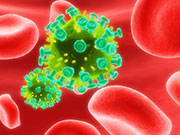
WEDNESDAY, Feb. 18, 2015 (HealthDay News) — HIV hid deep inside a young Mississippi girl born with the virus who suffered a disappointing relapse last July, after more than two years in which she appeared to have been cured by early, aggressive drug treatment, her doctors report.
They now know that the girl’s HIV was dormant all that time — not simply percolating undetected — because tests have shown that her recurring virus was an exact match to her mother’s HIV, said the girl’s pediatrician, Dr. Hannah Gay, of the University of Mississippi Medical Center, in Jackson.
“It appears that the virus had been dormant all of those many months and years, because there’s no evidence of diversity that would have been detected if low-level viral activity had been going on,” she explained.
Despite the setback, Gay and her colleagues believe that all babies born with HIV should receive the same rapid medical response as the Mississippi girl did, according to a letter they wrote in the Feb. 19 issue of the New England Journal of Medicine.
The girl, now nearly 5 years old, remained apparently virus-free for roughly two years after starting on a combination of three antiretroviral drugs within 30 hours of her birth.
Her remission continued even though she stopped taking HIV medications when she was 18 months old. Doctors had hoped her remission would open the door to a functional cure for all children born with the virus.
“Even though she did rebound, she had at least 27 months off of therapy,” Gay said. “That was 27 months of development without the ill effects of the virus and the ill effects of the medicines. This child benefited from a long remission.”
However, doctors should not assume that a child is HIV-free because they cannot detect any virus in their blood, Gay stressed.
In fact, it would be best if talk of a “functional cure” for HIV is dropped, Gay said.
“As we’ve studied this case and tried to describe her, we’ve developed a vocabulary of ‘remission’ rather than ‘functional cure,'” Gay said. “We think probably ‘remission and rebound’ or ‘remission and relapse’ are better and more communicative than ‘functional cure.'”
The girl’s relapse has reminded doctors that HIV is a sneaky virus that can hide deep in a person’s immune system.
The virus infects the “memory cells” of the immune system — cells that lie dormant deep within the system and retain the knowledge of how to respond to different types of infection. These cells wait in reserve, ready to be called upon to fight off a future illness.
HIV somehow found a way to quickly gain a foothold in the Mississippi girl’s immune system, despite the rapid and aggressive response to her condition. Because these cells are dormant, drug treatments that rid the bloodstream of HIV are not able to get inside them and kill off the virus hiding within.
“Somewhere inside the body of this child, there was at least one cell that had an intact infectious virus inside it,” said Rowena Johnston, vice president and director of research for amfAR, The Foundation for AIDS Research. “That cell or group of cells sat quietly and did nothing for two years, and then one day for some reason we don’t understand, it switched on and began replicating.”
Since the virus can hide so well, children born with HIV need to keep taking antiretroviral medication even if they appear virus-free, said Dr. Katherine Luzuriaga, a professor of molecular medicine and pediatrics at the University of Massachusetts Medical School in Worcester and lead author of the NEJM letter.
“What this and other cases tell us is our current efforts are not enough to prevent the formation of that reservoir of HIV in the body, or drop it low enough that patients can remain off antiretrovirals indefinitely,” Luzuriaga said.
Clinical trials are now underway that will further test this method of early, aggressive treatment for babies born with HIV, Luzuriaga and Johnston said.
Researchers hope that early treatment can prevent the development of a large HIV reservoir in these children, Gay said.
“If we can keep the reservoir very low, then as other interventions are developed, those kids are going to be the ones standing at the front of the line for a cure when that comes along,” she said.
This case also has shown researchers that they need better tests to detect HIV in the human body, Gay said.
“Our most sensitive measurements of the viral reservoir are not quite sensitive enough,” she said. “I think we suspected that already.”
Doctors normally put HIV-positive mothers on two antiretroviral medications prior to birth as a way of preventing transmission of the virus to their unborn children. After delivery, doctors test the newborns for HIV and continue treatment if the virus appears.
But in this girl’s case, no one knew the mother was HIV-positive before delivery. This prompted Gay to put the newborn on antiretroviral treatment immediately.
Tests showed progressively diminishing HIV levels in the infant’s blood, until it reached undetectable levels 29 days after birth. The child remained on antiretrovirals until 18 months of age, at which point doctors said they lost track of her and she stopped treatment.
Doctors next saw her about 10 months after her treatment ceased. The child underwent repeated standard HIV tests, which detected no virus in her blood.
More information
For more about HIV, visit the U.S. National Institutes of Health.
Copyright © 2025 HealthDay. All rights reserved.

